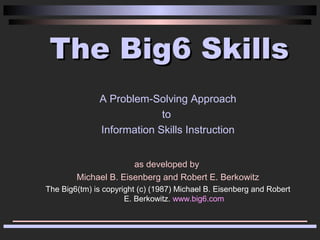
Big 6 pp
- 1. The Big6 Skills A Problem-Solving Approach to Information Skills Instruction as developed by Michael B. Eisenberg and Robert E. Berkowitz The Big6(tm) is copyright (c) (1987) Michael B. Eisenberg and Robert E. Berkowitz. www.big6.com
- 2. Scenario The Pokorny family wants to get a new dog. They’re going to use the Big6 research skills to help them decide what kind of dog to get.
- 3. 1. Task Definition Define the information problem (choose a topic). Identify the information needed to solve the problem. “Find the perfect dog for our family” -Identify Criteria: -Easy to train? Size? Short hair? Good with children? Cost?
- 4. 2. Information Seeking Strategies Brainstorm all possible sources. Select the best sources. “Where can we find information that will help us make our choice?” -Breed specific books? Encyclopedias? Magazines? Friends with dogs? Internet? Breeders? Vet?
- 5. 3. Location and Access Locate sources. Find information within sources. “Let’s start gathering quality information to help us make our decision…” -Visit the library, call breeders/vets, look online
- 6. 4. Use of Information Evaluate the information Take out needed information Put facts in your own words “Of the information we found, what is going to help us make our decision?” -Scan the information. Is it accurate? (from a reliable source?) Take notes. Use Index.
- 7. 5. Synthesis Organize information from all sources. Create your product to share information- (paper, poster, PowerPoint) “Let’s put this all together, draw conclusions, and make an educated decision.” -Put note/fact cards in logical order, categorize information, create spreadsheet with dog characteristics by breed, compare/contrast top choices to make best decision.
- 8. 6. Evaluation Edit your product. Check for mistakes. Judge the product- could you have done better? (Use rubric) “Are we happy with our new pet?” -Did we accurately determine if the pet was a good fit for our family? Did we find enough information? Was the information we found accurate?
- 9. What kind of dog did the Pokorny family choose? Louise
- 10. To sum up... Information literate people are those who have learned how to learn. They are prepared for life long learning because they can always find the information needed for any task or decision at hand.
Editor's Notes
- First step is to recognize that an information need -task – find the perfect dog for our family - we need information about a variety of dogs to determine which one would be best for our family - Identify the information needed -this is where the family would set the criteria for the type of dog they want; easy to train, short hair, good with children; cost;
- - the family must consider all possible information sources and begin to develop a plan for searching. -list where to find information on a topic -breed specific books, encyclopedias, magazines, the vet, breeders, friends with dogs, the Internet
- -family must now locate information from a variety of resources and access specific information found within individual resources. -locate sources – go to the library, finding books on shelves, book stores for magazines, phone breeders and vets for information -search for web sites on the Internet -find information within sources - use table of contents, index, glossary to find information within a resource -use search tools and commands for searching Internet, CD-ROMs
- After finding the resources the family must engage the information to determine its relevance and extract information. -scan the information in a book to determine whether or not it will be useful -download information from Internet, bookmark sites -take jot notes on information read, viewed or interviewed -analyze data on spreadsheets, graphs, charts, databases -determine the quality of information found– bias? From breeders? False information from fans of a breed? Is the web site endorsed by Canadian Kennel Club or America Kennel Club?
- Family must organize and communicate the results of the information problem-solving effort. put jot note fact cards in a logical order categorize information create database or spreadsheet to store information on dog characteristics create a printout of database or spreadsheet interpret and communicate findidngs and conclusions
- -judge the product – are we happy with our new pet? – it ’s a long term commitment! -does the dog fit the criteria as determined at the beginning of the project or have we chosen to amend our criteria as we found more information determine whether the information need, as originally defined, is met -judge the process – efficiency - reflect on what worked well this time and what you would do differently next time
